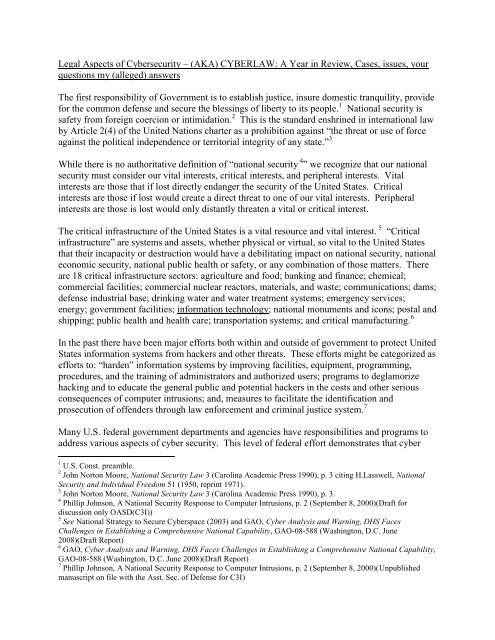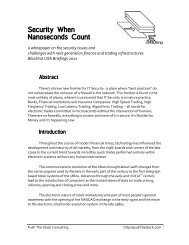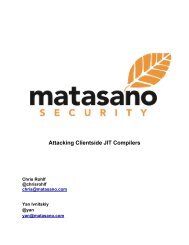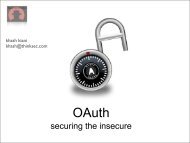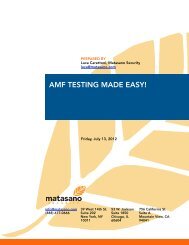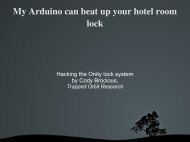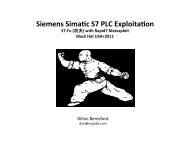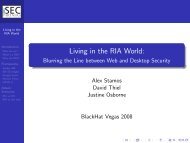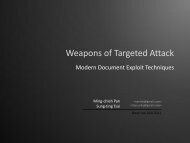Legal Aspects of Cybersecurity â (AKA) CYBERLAW: A ... - Hakim
Legal Aspects of Cybersecurity â (AKA) CYBERLAW: A ... - Hakim
Legal Aspects of Cybersecurity â (AKA) CYBERLAW: A ... - Hakim
- No tags were found...
You also want an ePaper? Increase the reach of your titles
YUMPU automatically turns print PDFs into web optimized ePapers that Google loves.
security is a national priority. However, critics claim that the many organizations and programsare unnecessarily duplicative and the Nation lacks a coherent strategy for understanding the truecyber security threat or the roles and responsibilities <strong>of</strong> each federal government organization. 8Cyber space means the interdependent network <strong>of</strong> information technology infrastructures. 9 Thebody <strong>of</strong> law and regulation that govern “cyber space” refer to it in terms <strong>of</strong> “computer networkoperations.” Computer network operations have their foundations in statutes, legal precedentsand several layers <strong>of</strong> implementing regulations issued by the federal government. Theseregulations clearly state that cyber security or computer network security is the prevention <strong>of</strong>damage to, protection <strong>of</strong>, and restoration <strong>of</strong> computers, electronic communications systems,electronic communication services, wire communication, and electronic communication,including information contained therein, to ensure its availability, integrity, authentication,confidentiality, and non-repudiation. 10To accomplish this huge task computer network operations rely upon multiple disciplines withinand outside <strong>of</strong> the federal government. Each one <strong>of</strong> these numerous organizations use theirinherent capabilities and authorities to accomplish computer network operations and given thecomplexity <strong>of</strong> the global information grid, computer network operations requires closecooperation between network operations, intelligence, communications, counterintelligence andlaw enforcement communities. Moreover, the civilian/private counterparts operate in aremarkable similar fashion, they have CERTS/CIRTS and system administrators to act as firstline defenders against unauthorized access and use.To maneuver through this complicated process we call computer network operations requires akeen understanding <strong>of</strong> the multiple disciplines involved and the authorities and limitations eachbrings into CNO. This requires an understanding <strong>of</strong> two factors: first, one must understand theroles and responsibilities <strong>of</strong> each <strong>of</strong> the above identified disciplines; and, second, one mustunderstand the basic foundations <strong>of</strong> the legal authorities used in CNO. The former requirementrequires an analysis <strong>of</strong> the individual authorities that each discipline brings into CNO and a keenunderstanding <strong>of</strong> the limitations placed upon each <strong>of</strong> the disciplines. In other words, we must beextremely concerned with mission creep as it relates to computer network operations. Strictstatutory construction, 11 as it is used by the Courts to interpret statutes, is helpful inunderstanding the roles and limitations <strong>of</strong> the various disciplines, operators, systemadministrators, law enforcement, counterintelligence, and intelligence. All the regulations thatestablish CNO identify these specific disciplines to assist in computer network security. Theyare named for a reason - - to adhere to existing laws and to avoid the previous abuses that8 John Rollins and Clay Wilson, Terrorist Capabilities for Cyberattack: Overview and Policy Issues, CRS Report forCongress p. 7 (January 22, 2007)9 Lieutenant Colonel Joshua E. Kastenberg, Non-Intervention and Neutrality in Cyberspace: An Emerging Principlein the National Practice <strong>of</strong> International Law, 64 A.F. L. REV. 43, p 48 (2009) citing, National Security PresidentialDirective 54/Homeland Security Presidential Directive 23, “<strong>Cybersecurity</strong> Policy” (8 January 2008)10 Deputy Assistant Secretary <strong>of</strong> Defense for Cyber, Identity, and Information Assurance Strategy, ASD NII/DoDCIO, p. 1 (August 2009) found at, www.cio-nii.defense.gov/docs/DoD_IA_Strategic_Plan.pdf, citing, NationalSecurity Presidential Directive 54/Homeland Security Presidential Directive 23, “<strong>Cybersecurity</strong> Policy” (8 January2008) and Shon Harris, CISSP All in One Certification Exam Guide, p. 62 - 64 (McGraw Hill 2002)11 Courts first look to the plain meaning <strong>of</strong> the terms <strong>of</strong> the statute in order to discern whether those terms impartsufficient clarity to a person <strong>of</strong> ordinary intelligence. See United States v. Spy Factory, 951 F. Supp. 450 (S.D. N.Y.1997).
occurred in the name <strong>of</strong> domestic national security. 12 That means a lot <strong>of</strong> moving parts andmuch has been written already. 13 So why do I think I have anything to add to this? What could Iadd? Well, we will discuss that below.First I would like to make what I think is a critical point for this entire area <strong>of</strong> full spectrumcomputer network operations. Words matter. As Catherine J.K. Sandoval, Assistant Pr<strong>of</strong>essor<strong>of</strong> Law, Santa Clara University School <strong>of</strong> Law and Co-Director, Broadband Institute <strong>of</strong>California, stated in, Disclosure, Deception, and Deep-Packet Inspection: The Role <strong>of</strong> theFederal Trade Commission Act’s Deceptive Conduct Prohibitions in the Net Neutrality Debate,78 Fordham L. Rev. 641 (November 2009), “When I use a word,” Humpty Dumpty said … “itmeans just what I choose it to mean – neither more nor less.” (Citing Lewis Carroll, Through theLooking Glass 106 (Schocken Books 1987)(1872)).Computer network operations involve events, incidents, intrusions, and attacks and those areresponded to by numerous agencies using a multitude <strong>of</strong> differing authorities that will fall undercomputer network security; computer network defense; computer network exploitation; and/or,computer network attack. So because words and definitions do matter we need to stop callingeverything that happens to someone’s network or computer an attack. If everything is an attack,then nothing is an attack. And if everything is an attack then the Department <strong>of</strong> Defense needs totake charge since they are responsible for fighting and winning the country’s wars. 14 Okay, Iknow I am being unrealistic. For example look at the story, “DNS Attack Briefly Takes DownE-Commerce Sites.” 15 That’s a lot sexier than, “DNS Intrusions Briefly Takes Down E-Commerce Sites.” But words will matter when it comes to deciding who has primaryjurisdiction over what computer network event, incident, intrusion, or yes, “attack.”And just as using the correct word is important so is using the correct authority. For many years12 United States v. United States District Court for the Eastern District <strong>of</strong> Michigan, 407 U.S. 297 (1972) (referred toas the "Keith" case).13 See Sean Condron, Getting It Right: Protecting American Critical Infrastructure in Cyberspace, 20 Harv. J. Law &Tec 404 (2007); Alan F. Williams, Prosecuting Website Development Under the Material Support to TerrorismStatutes: Time to Fix What’s Broken, 11 N.Y.U. J. Legis. & Pub. Pol’y 365 (2007/2008); Thomas Wingfield, Whenis a Cyber Attack an Armed Attack, Potomac Institute for Policy Studies (February 2006); Todd M. Hinnen, TheCyber-Front in the War on Terrorism: Curbing Terrorist Use <strong>of</strong> the Internet, 5 Colum. Sci. & Tech. L. Rev. 3(2003/2004); Winston P. Nagan, The New Bush National Security Doctrine and the Rule <strong>of</strong> Law, 22 Berkeley J.Int’l L. 375 (2004); Eric Jensen, Unexpected Consequences From Knock-On Effects: A Different Standard forComputer Network Operations, 18 Am. U. Int’l Rev. 1145 (2003); Eric Jensen, Computer Attack on CriticalNational Infrastructure: A Use <strong>of</strong> Force Invoking the Right <strong>of</strong> Self-Defense, 38 Stan. J. Int’l 207 (2002); Mary EllenO’Connell, The Myth <strong>of</strong> Preemptive Self-Defense, The American Society <strong>of</strong> International Law: Task Force onTerrorism (August 2002); LTC Dhillon and LTC Smith, Defensive Information Operations and Domestic Law:Limitations on Government Investigative Techniques, 50 A.F. L. Rev. 135 (2001); William C. Banks, M.E.Bowman, Executive Authority for National Security Surveillance, 50 Am. U.L. Rev. 1 (October 2000); Roger D.Scott, Territorial Intrusive Intelligence Collection and International Law, 46 A.F. L. Rev. 217 (1999); Michael N.Schmitt, Computer Network Attack and the Use <strong>of</strong> Force in International Law: Thoughts on a NormativeFramework, 37 Colum. J. Transnat’l L. 885 (1999); Todd A. Morth, Considering Our Position: Viewing InformationWarfare as a Use <strong>of</strong> Force Prohibited by Article 2(4) <strong>of</strong> the U.N. Charter, 30 Case W. Res. J. Int’l L. 567(Spring/Summer 1998); Roger Scott “<strong>Legal</strong> <strong>Aspects</strong> <strong>of</strong> Information Warfare: Military Disruption <strong>of</strong>Telecommunications, 45 Naval L. Rev. 57 (1998); and, Lawrence Greenberg, Information Warfare and InternationalLaw, National Defense University Press (1997).14 U.S. Dep’t <strong>of</strong> Def., National Defense Strategy, p.6 (June 2008) available athttp://www.defense.gov/news/2008%20National%20Defense%20Strategy.pdf.15 See http://gigalaw.blogspot.com/2009/12/dns-attack-briefly-takes-down-e.html (Source: CNN.com).
I have heard the cry for new legislation so various agencies could conduct a variety <strong>of</strong>“operations.” While I realize there are global issues that need resolution, I am talking about thecries for new authorities that come from my tech colleagues. Remarkably, I believe all the legalauthorities already exist necessary to accomplish full spectrum computer network operations.The challenge is not obtaining new legislation but rather identifying the correct organization orentity that has the right authority for the right action.Curtis Karnow states, “The Internet, and its language <strong>of</strong> code, are global; they are notcoterminous with any <strong>of</strong> the usual means <strong>of</strong> enforcement <strong>of</strong> laws and values, because the Internetis not coterminous with any country, region, or cultural group. The Internet gathers those whohave no contractual relationship, no spoken language in common, and are not bound by acommon law. Trade sanctions will not assist. Nations will not permit their citizens to be policeddirectly by authorities across the globe.” 16Sean Condron captured this best, “Homeland security is a concerted national effort to preventterrorist attacks within the United States, reduce America’s vulnerability to terrorism, andminimize the damage and recover from attacks that do occur. 17 In contrast, homeland defense isthe protection <strong>of</strong> U.S. sovereignty, territory, domestic population, and critical defenseinfrastructure against external threats and aggression, or other threats as directed by thePresident. 18 The Department <strong>of</strong> Homeland Security is the federal agency in charge <strong>of</strong> homelandsecurity while the Department <strong>of</strong> Defense is the lead federal agency for homeland defense.” 19To promote security, DHS was established to strengthen measures for protectingtelecommunications and other critical infrastructure services; coordinate efforts to protect criticalpublic and privately owned information systems within the United States from terrorist attack;coordinate efforts to ensure rapid restoration <strong>of</strong> telecommunications and other criticalinfrastructure facilities; and, coordinate efforts to ensure rapid restoration <strong>of</strong> public and privatecritical information systems. 20 Within the National Cyber Security Division <strong>of</strong> the Department<strong>of</strong> Homeland Security, the US-CERT serves as a focal point for addressing computer networksecurity incidents within the federal government. One <strong>of</strong> the primary functions <strong>of</strong> the US-CERTis to increase the federal government’s awareness <strong>of</strong> computer network threats and16 Curtis E.A. Karnow, Launch on Warning: Aggressive Defense <strong>of</strong> Computer Systems, 9 Int’l J. Comm. L. & Pol’y4 (Fall 2004)17 Sean Condron, Getting it Right: Protecting American Critical Infrastructure in Cyberspace, 20 Harv. J. Law & Tec404, p 404 (Spring 2007) citing 6 U.S.C.A. § 111(b)(1)(A)-(C) (West 2002); see also THE PRESIDENT OF THEUNITED STATES, NATIONAL STRATEGY FOR HOMELAND SECURITY 30 (2002) [hereinafterHOMELAND SECURITY], available at http://www.whitehouse.gov/homeland/book/nat_strat_hls.pdf. HomelandSecurity Presidential Directive 7 suggests an expansion <strong>of</strong> critical infrastructure sectors when it assigns roles andresponsibilities <strong>of</strong> sector-specific federal agencies. See PRESIDENT OF THE UNITED STATES, HOMELANDSECURITY PRESIDENTIAL DIRECTIVE 7 (2003), available athttp://www.whitehouse.gov/news/releases/2003/12/20031217-5.html.18 Sean Condron, Getting it Right: Protecting American Critical Infrastructure in Cyberspace, 20 Harv. J. Law & Tec404, p 404 (Spring 2007) citing 42 U.S. DEP’T OF DEF., STRATEGY FOR HOMELAND DEFENSE AND CIVILSUPPORT 5 (2005) [hereinafter HOMELAND DEFENSE], available athttp://www.defenselink.mil/news/Jun2005/d20050630homeland.pdf.19 Sean Condron, Getting it Right: Protecting American Critical Infrastructure in Cyberspace, 20 Harv. J. Law & Tec404, p 404 (Spring 2007)(Citations omitted).20 Exec. Order 13228, “Establishing the Office <strong>of</strong> Homeland Security and the Homeland Security Council,” 66 Fed.Reg. 51812 (Oct. 8, 2001); 6 U.S.C. §§ 101 et seq.
vulnerabilities thereby increasing the government’s ability to prepare for and respond tocomputer network security events. The US-CERT is the Federal government’s computernetwork security organization responsible for increasing the security <strong>of</strong> federal systems.The main three principles <strong>of</strong> security are confidentiality, integrity and availability. 21Confidentiality provides the ability to ensure that the necessary level <strong>of</strong> security is enforced ateach junction <strong>of</strong> data processing and prevention <strong>of</strong> unauthorized disclosure. 22 Integrity is upheldwhen the assurance <strong>of</strong> accuracy and reliability <strong>of</strong> information and systems is provided, andunauthorized modification <strong>of</strong> data is prevented. 23 Availability is that the systems and networksshould provide adequate capacity in order to perform in a predictable manner with the acceptablelevel <strong>of</strong> performance. 24Cyberspace means the interdependent network <strong>of</strong> information technology infrastructures. 25“<strong>Cybersecurity</strong> or computer network security is the prevention <strong>of</strong> damage to, protection <strong>of</strong>, andrestoration <strong>of</strong> computers, electronic communications systems, electronic communicationservices, wire communication, and electronic communication, including information containedtherein, to ensure its availability, integrity, authentication, confidentiality, and nonrepudiation.”26 “Computer network defense is the mission to defend computer systems andnetworks from unauthorized activity and other activity, which degrade mission performance andadversely impact survivability.” 27 This mission is to be accomplished by using communications,law enforcement, counterintelligence, and intelligence community capabilities in response tospecific or potential threats. 28 The inclusion <strong>of</strong> defense against potential threats is another clearstatement <strong>of</strong> the United States commitment to apply anticipatory self-defense in the area <strong>of</strong>CNO.” 2921 44 U.S.C. § 3542(b)(1)(A-C) and see Shon Harris, CISSP All in One Certification Exam Guide, p. 62 (McGrawHill 2002)22 Shon Harris, CISSP All in One Certification Exam Guide, p. 63 (McGraw Hill 2002)23 Shon Harris, CISSP All in One Certification Exam Guide, p. 63 (McGraw Hill 2002)24 Shon Harris, CISSP All in One Certification Exam Guide, p. 64 (McGraw Hill 2002)25 Statement for the Record Lieutenant General Keith Alexander, Commander Joint Functional ComponentCommand for Network Warfare, Before the House Armed Services Committee Terrorism, Unconventional Threats,and Capabilities Subcommittee (5 May 2009) citing Deputy Secretary <strong>of</strong> Defense Memorandum, Subject: TheDefinition <strong>of</strong> Cyberspace, May 12, 2008 (The Department <strong>of</strong> Defense holds this definition is consistent with thedefinition <strong>of</strong> cyberspace provided in National Security Presidential Directive 54/Homeland Security PresidentialDirective 23 (NSPD-54/HSPD-23), which states that cyberspace is “the interdependent network <strong>of</strong> informationtechnology infrastructures, and includes the Internet, telecommunications networks, computer systems, andembedded processors and controllers in critical industries. Common usage <strong>of</strong> the term also refers to the virtualenvironment <strong>of</strong> information and interactions between people.). Found athttp://armedservices.house.gov/pdfs/TUTC050509/Alexander_Testimony050509.pdf26 Deputy Assistant Secretary <strong>of</strong> Defense for Cyber, Identity, and Information Assurance Strategy, ASD NII/DoDCIO, p. 1 (August 2009) found at, www.cio-nii.defense.gov/docs/DoD_IA_Strategic_Plan.pdf , citing, NationalSecurity Presidential Directive 54/Homeland Security Presidential Directive 23, “<strong>Cybersecurity</strong> Policy” (8 January2008)27 Eric Talbot Jensen, Computer Attacks on Critical National Infrastructure: A Use <strong>of</strong> Force Invoking the Right <strong>of</strong>Self-Defense 38 Stan. J Int’l L. 207, fn 138 (Summer, 2002)28 Eric Talbot Jensen, Computer Attacks on Critical National Infrastructure: A Use <strong>of</strong> Force Invoking the Right <strong>of</strong>Self-Defense 38 Stan. J Int’l L. 207, fn 138 (Summer, 2002).29 Eric Talbot Jensen, Computer Attacks on Critical National Infrastructure: A Use <strong>of</strong> Force Invoking the Right <strong>of</strong>Self-Defense 38 Stan. J Int’l L. 207, fn 138 (Summer, 2002).
Computer network exploitations are enabling operations and intelligence collection capabilitiesconducted through the use <strong>of</strong> computer networks to gather data from target or adversaryautomated information systems or networks. 30 Computer network attack is action taken throughthe use <strong>of</strong> computer networks to disrupt, deny, degrade, or destroy information resident incomputers and computer networks, or the computers and networks themselves. 31There are several definitions used to explain access that occurs on a computer networksystem.-Security event - an occurrence in a system that is relevant to the security <strong>of</strong> the system. Theterm covers both events that are security incidents and those that are not. 32-Security incident – (1) a security event that involves a security violation, in other words, asecurity event in which the system’s security policy is disobeyed or otherwise breached; (2) anyadverse event that compromises some aspect <strong>of</strong> computer or network security; (3) a violation orimminent threat <strong>of</strong> violation <strong>of</strong> computer security policies, acceptable use policies, or standardcomputer security practices. 33-Security intrusion – a security event, or a combination <strong>of</strong> multiple security events, thatconstitutes a security incident in which an intruder gains, or attempts to gain, access to a systemor system resource without having authorization to do so. 34-Attack – (1) An intentional act by which an entity attempts to evade security services andviolate the security policy <strong>of</strong> a system. That is, an actual assault on system security that derivesfrom an intelligent threat; (2) a method or technique used in an assault. 3530 Joint Chiefs <strong>of</strong> Staff, Joint Pub. 1-02, Department <strong>of</strong> Defense Dictionary <strong>of</strong> Military and Related Terms 203 (12Apr 2001).31 Joint Chiefs <strong>of</strong> Staff, Joint Pub. 1-02, Department <strong>of</strong> Defense Dictionary <strong>of</strong> Military and Related Terms 203 (12Apr 2001).32 R. Shirey, Internet Security Glossary, Version 2, Request For Comments 4949, p. 268 (The IETF Trust, August2007) at http://www.rfc-editor.org/rfc/rfc4949.txt and NIST SP 800-61 and NIST SP 800-61 Computer SecurityIncident Handling Guide (Draft) July 2008.33 R. Shirey, Internet Security Glossary, Version 2, Request For Comments 4949, p. 269 (The IETF Trust, August2007) at http://www.rfc-editor.org/rfc/rfc4949.txt.34 R. Shirey, Internet Security Glossary, Version 2, Request For Comments 4949, p. 269 (The IETF Trust, August2007) at http://www.rfc-editor.org/rfc/rfc4949.txt.35 R. Shirey, Internet Security Glossary, Version 2, Request For Comments 4949, p. 21 (The IETF Trust, August2007) at http://www.rfc-editor.org/rfc/rfc4949.txt.
Precedents in <strong>Cybersecurity</strong> and Cases from the past year.United States v Prochner, 417 F.3d 54 (1 st Cir. 2005)Special Skill EnhancementDefendant appeals from his sentence on a conviction <strong>of</strong> access device (credit card) fraud. Hepled guilty to knowingly possessing fifteen or more unauthorized credit card numbers with theintent to defraud in violation <strong>of</strong> 18 U.S.C. § 1029(a)(3). District court sentenced him to 25months in prison and three years <strong>of</strong> supervised release, and ordered restitution in the amount <strong>of</strong>$2,610.19. The sentence was based in part on enhancements for the amount <strong>of</strong> loss, number <strong>of</strong>victims, special skill, and obstruction <strong>of</strong> justice. Defendant challenges the enhancement for use<strong>of</strong> a special skill.On August 20, 2002, Prochner was trying to enter Canada from New York when Canadian lawenforcement <strong>of</strong>ficers conducting border inspections discovered that he was carrying papers and anotebook containing numerous credit card numbers. Further investigation revealed that thecredit card numbers had been reported as stolen or lost and that fraudulent activity had beenreported on the accounts. After being advised <strong>of</strong> his rights, Prochner admitted that he hadobtained the credit card numbers on the Internet. In a written statement to law enforcement, heexplained that he accessed website order logs to obtain the credit card numbers and thenaccessed channels where he determined that the numbers were still valid.In addition to the credit card numbers, Prochner had in his possession a handwritten journalthat included references to adolescent males.SentencingThe presentence report (PSR) determined that Prochner's base <strong>of</strong>fense level was 6; added 4 levelsfor the loss <strong>of</strong> $ 17,000 ($ 500 multiplied by 34 credit card numbers); 2 levels for the number <strong>of</strong>victims (between 10 and 50); 2 levels for the use <strong>of</strong> a special skill; and, 2 levels for obstruction<strong>of</strong> justice. The resulting <strong>of</strong>fense level totaled 16. Defendant had no prior convictions and zerocriminal history points, he was assigned to Criminal History Category I. The resulting guidelinesentencing range was 21 to 27 months. The Probation Office calculated that Prochner owed $2,610.19 in restitution.Special Skill EnhancementProchner contends the court erred in finding that, to facilitate the <strong>of</strong>fense, he used a "specialskill," as defined in sentencing guidelines, to obtain the credit card numbers.The Guidelines direct that a two-level enhancement is applied "if the defendant . . . used aspecial skill, in a manner that significantly facilitated the commission or concealment <strong>of</strong> the<strong>of</strong>fense." A "special skill" is defined as "a skill not possessed by members <strong>of</strong> the general publicand usually requiring substantial education, training or licensing." Examples include "pilots,lawyers, doctors, accountants, chemists, and demolition experts.
We have held that a defendant need not necessarily have formal education or training in order tobe found to possess a special skill. Montero-Montero, 370 F.3d at 123; United States v. Nelson-Rodriguez, 319 F.3d 12, 58 (1st Cir. 2003); United States v. Noah, 130 F.3d 490, 500 (1st Cir.1997). A special skill may also be acquired through experience or self-tutelage. Noah, 130 F.3dat 500 (finding that a self-taught, pr<strong>of</strong>essional tax preparer utilized a special skill in preparingand electronically filing tax returns).The district court adopted the PSR's conclusion that Prochner "used self-taught computer skills to'hack' into website order logs." Prochner argues, however, that there is no evidence that he haseducation or training (even self-taught) in computers. But a court can reasonably infer requisiteself-education from the nature and extent <strong>of</strong> the skill possessed. Here, Prochner's owndescription <strong>of</strong> what he did and could do to hack into secure websites and purloin data revealed ahigh and unusual level <strong>of</strong> computer know-how. The court could infer that this came from selftutelageand experience if not from more formal training.In his written statement to law enforcement at the time he was arrested, Prochner explained howhe had obtained the credit card numbers:After accessing the internet, via telnet and MIRC/PIRCH and accessing websites’order logs via Cart32 (internet credit card ordering programs), I scanned twentysome credit cards . . . . Credit cards can be checked for validity via bots (i.e.,scripts that check cards are still active/inactive), and I used a (MIRC) basedprogram via Windows 98SE, on an Undernet channel and a Dalnet based channelto check three or four AMEX cards and found them to be "extremely" valid.Prochner went on to elaborate on what he called "carding," including how websites use SSLencryption, how one can rewrite the websites' "cgi scripts" which ultimately hold the "logs" forcredit card orders for a particular website, and how one can download an international chat clientto access thousands <strong>of</strong> channels where one can check the validity <strong>of</strong> all kinds <strong>of</strong> credit cardnumbers. He stated that these channels are "where the true criminals are." Prochner went on toexplain that "[he] can easily access these places [at] any computer [at] any time <strong>of</strong> the day, via aWindows Based program." He also claimed that "even without log orders or hacking (for lack <strong>of</strong>a better word) tools, a novice Internet surfer can access these channels and still get hundreds <strong>of</strong>credit cards in less than 2 [hours]."A skill can be special even though the activity to which the skill is applied is mundane." Id. Thecritical question is "whether the defendant's skill set elevates him to a level <strong>of</strong> knowledge andpr<strong>of</strong>iciency that eclipses that possessed by the general public. Noah, 130 F.3d at 500.Prochner's description <strong>of</strong> the processes to obtain the credit card numbers amply supports thedistrict court's conclusion that Prochner's special skills, including the ability to "hack" intowebsite order logs and computer networks and to re-write "cgi scripts," exceed the knowledge <strong>of</strong>the average Internet user. Even without expert evidence, Prochner's affidavit supports finding alevel <strong>of</strong> sophistication well beyond the ordinary. We are unable to say, therefore, that the districtcourt's determination that Prochner possessed a special skill not possessed by members <strong>of</strong> thegeneral public is clearly erroneous.
Wi-FiIn re Google Inc. Street View Electronic Communications Litigation, --- F.Supp.2d ----, 2011WL 2571632 (N.D.Cal. June 29, 2011)Plaintiffs bring this putative class action against Google alleging three causes <strong>of</strong> action forviolation <strong>of</strong> the federal Wiretap Act, violation <strong>of</strong> Cal. Bus. & Pr<strong>of</strong>.Code §§ 17200, et seq., andviolation <strong>of</strong> various state wiretap statutes. Plaintiffs allege that Defendant intentionallyintercepted data packets, including payload data, from Plaintiffs' Wi–Fi networks utilizingspecially designed packet sniffer s<strong>of</strong>tware installed on Defendant's Google Street View vehicles.Before the Court is Defendant's Motion to Dismiss. The Court dismisses the state wiretap claimsas preempted by the Federal wiretap Act. But the other two causes <strong>of</strong> action move forward.Google alleged to have Google Street View vehicles equipped with nine directional cameras tocapture 360 degree views <strong>of</strong> the streets and 3G/GSM/Wi–Fi antennas with custom-designeds<strong>of</strong>tware for the capture and storage <strong>of</strong> wireless signals and data. The data collection system iscommonly known as a packet analyzer, wireless sniffer, network analyzer, packet sniffer orprotocol analyzer.The matter before the Court presents a case <strong>of</strong> first impression as to whether the Wiretap Actimposes liability upon a defendant who allegedly intentionally intercepts data packets from awireless home network.Plaintiff’s complaint alleges that Google intentionally intercepted electronic communicationssent or received on wireless internet connections. Based on the allegations above, the Courtfinds that Plaintiffs plead facts sufficient to state a claim for violation <strong>of</strong> the Wiretap Act. Inparticular, Plaintiffs plead that Defendant intentionally created, approved <strong>of</strong>, and installedspecially-designed s<strong>of</strong>tware and technology into its Google Street View vehicles and used thistechnology to intercept Plaintiffs' data packets, arguably electronic communications, fromPlaintiffs' personal Wi–Fi networks. Further, Plaintiffs plead that the data packets weretransmitted over Wi–Fi networks that were configured such that the packets were not readable bythe general public without the use <strong>of</strong> sophisticated packet sniffer technology. Although Plaintiffsfail to plead that the wireless networks fall into at least one <strong>of</strong> the five enumerated exceptions toSection 2510(16)'s definition <strong>of</strong> “readily accessible to the general public” for radiocommunications, the Court finds that the wireless networks were not readily accessible to thegeneral public as defined by the particular communication system at issue, wireless internetnetworks, which are not “radio communications,” as the term was intended by Congress indrafting Section 2510(16).Rather, application <strong>of</strong> the Section 2510(16) definition <strong>of</strong> “readily accessible to the generalpublic” as narrowly defined for traditional radio broadcast technology, would be inapplicable tothe determination <strong>of</strong> whether Plaintiffs' allegedly intercepted data packets from their Wi–Finetworks are readily accessible to the general public for purposes <strong>of</strong> exemption G1, despite thefact that wireless networks transmit data using radio waves. As the Court has found, Congressintended Section 2510(16)'s definition to resolve the issue <strong>of</strong> radio scanning devices used to
intercept radio broadcasts by establishing a presumption that traditional radio services were“readily accessible to the general public,” in accord with the design <strong>of</strong> the medium as one wheremost communications over that medium are intended to be public. Unlike in the traditionalradio services context, communications sent via Wi–Fi technology, as pleaded by Plaintiffs,are not designed or intended to be public. Rather, as alleged, Wi–Fi technology shares acommon design with cellular phone technology, in that they both use radio waves totransmit communications, however they are both designed to send communicationsprivately, as in solely to select recipients, and both types <strong>of</strong> technology are architected inorder to make intentional monitoring by third parties difficult. S.Rep. No. 99–541, at 6(1986). (Emphasis added.)Further, applying Section 2510(16)'s narrow definition <strong>of</strong> “readily accessible to the generalpublic” to wireless networks, a technology unknown to the 99th Congress who drafted andpassed the ECPA, would contravene the primary stated purpose <strong>of</strong> the amendment, which was toupdate the Wiretap Act to include within the Act specific protections against intentionalinterceptions <strong>of</strong> computer-to-computer communications and so-called “electronic mail” or email;data Plaintiffs plead was included in the data packets intercepted by Defendant. Interpreting theECPA such that the statute provides obscure limitations on the protection <strong>of</strong> emails and othercomputer-to-computer communications based on the particular medium that transmitted theelectronic communication would render the Wiretap Act, and the efforts <strong>of</strong> the 99th Congress toprovide such protections, absurd. Under such an interpretation, the Act would provide a privatecivil right <strong>of</strong> action, and even impose criminal liability, for the interception <strong>of</strong> emails transmittedover an ethernet cable through a wired network, but would stop short at protecting those verysame emails should they pass momentarily over radio waves through a Wi–Fi networkestablished to transmit data within a home.Defendant's contention that Plaintiffs fail to state a claim for violation <strong>of</strong> the Wiretap Act, asPlaintiffs plead that their networks were “open” and “unencrypted,” is misplaced. WhilePlaintiffs plead that their networks, or electronic communications systems, were configured suchthat the general public may join the network and readily transmit electronic communicationsacross that network to the Internet, Plaintiffs plead that the networks were themselves configuredto render the data packets, or electronic communications, unreadable and inaccessible withoutthe use <strong>of</strong> rare packet sniffing s<strong>of</strong>tware; technology allegedly outside the purview <strong>of</strong> the generalpublic. Thus, the Court finds that Plaintiffs plead facts sufficient to support a claim that the Wi–Fi networks were not “readily accessible to the general public,” such that exemption G1 wouldnot apply.Defendant's interpretation <strong>of</strong> United States v. Ahrndt as standing for the principle that allunencrypted wireless networks are readily accessible to the general public and, thus, anyinterceptions from those networks are obviated from liability under exemption G1, undulyextends the doctrine. (Motion at 10–11.) In Ahrndt, a neighbor was connected to the Internet viaher own wireless network when her network malfunctioned and her computer automaticallylogged in to another open wireless network operated by the defendant. Id. at 1. The defendanthad administered his iTunes s<strong>of</strong>tware as set to “share,” such that other users on the same networkwould be able to access all files that the defendant had stored in his iTunes libraries. Id. Afterbeing automatically logged into the defendant's wireless network, the plaintiff in Ahrndt began
using her own iTunes program and noticed that the defendant's iTunes library was accessible. Id.In accessing the defendant's iTunes library, the plaintiff located a number <strong>of</strong> files containingchild pornography in a subfolder within the shared directory. Id. Based on these facts, JudgeKing held that the plaintiff's interception was not illegal and was, in fact, “expressly lawful”under the Wiretap Act as the defendant's network and iTunes s<strong>of</strong>tware were configured to bereadily accessible to the general public. Id. at 8. However, the court did not base its holdingmerely on the fact the defendant's network was unencrypted. Id. Rather, Judge King found that“defendant's conduct in operating his iTunes s<strong>of</strong>tware with the preferences set to share, inconjunction with maintaining an unsecured wireless network router, diminished his reasonableexpectation <strong>of</strong> privacy to the point that society would not recognize it as reasonable.” Id. at 8.Unlike in Ahrndt, here, Plaintiffs plead that, although the networks themselves wereunencrypted, the networks were configured to prevent the general public from gaining access tothe data packets without the assistance <strong>of</strong> sophisticated technology. Thus, the Court finds that,without more, merely pleading that a network is unencrypted does not render that networkreadily accessible to the general public and serve to remove the intentional interception <strong>of</strong>electronic communications from that network from liability under the ECPA.United States v. Ahrndt, 2010 WL 373994 (D.Or. Jan 28, 2010)Before the court is defendant's Motion to Suppress, which seeks to suppress evidence defendantalleges was obtained as a result <strong>of</strong> an illegal search in violation <strong>of</strong> his constitutional rights underthe Fourth Amendment. For the following reasons, I deny defendant's motion.Defendant’s neighbor erroneously connects to his open and unencrypted Wi-Fi, SSIDBelkin54G, and observes files with child pornography names. Neighbor contacts LEA.In order to benefit from Fourth Amendment protections, an individual must demonstrate asubjective expectation that his activities would be private, and he must show that his expectationwas one that society is prepared to recognize as reasonable." U.S. v. Young, 573 F.3d 711, 715-16 (9th Cir. 2009) (internal citations omitted). Evidence seized in violation <strong>of</strong> the FourthAmendment constitutes an illegal search or seizure. See Pennsylvania Bd. <strong>of</strong> Prob. and Parole v.Scott, 524 U.S. 357, 362, 118 S. Ct. 2014, 141 L. Ed. 2d 344 (1998). Evidence seized during anillegal search is tainted and should not be included in the affidavit for a search warrant.Inclusion <strong>of</strong> tainted evidence in the affidavit though, does not in itself taint the warrant orevidence seized pursuant to it. The court should excise the tainted evidence and decide if theremaining, untainted evidence provides probable cause to issue a warrant. United States v.Bishop, 264 F.3d 919, 924 (9th Cir. 2001). Furthermore, to be untainted by the prior illegalsearch, the <strong>of</strong>ficer's decision to seek the warrant must not have been prompted by what he sawduring the prior illegal search. United States v. Hill, 55 F.3d 479, 481 (9th Cir. 1995)."The extent to which the Fourth Amendment provides protection for the contents <strong>of</strong> electroniccommunications in the Internet age is an open question. The recently minted standard <strong>of</strong>electronic communication via e-mails, text messages, and other means opens a new frontier inFourth Amendment jurisprudence that has been little explored." Quon v. Arch WirelessOperating Co., Inc., 529 F.3d 892, 904 (9th Cir. 2008).
The issue in this case is whether the Fourth Amendment provides a reasonable, subjectiveexpectation <strong>of</strong> privacy in the contents <strong>of</strong> a shared iTunes library on a personal computerconnected to an unsecured home wireless network.Defendant argues that when Officer McCullough duplicated the steps taken by JH and vieweddefendant's child pornography, he conducted an illegal warrantless search in violation <strong>of</strong>defendant's Fourth Amendment right to privacy. According to Defendant, a warrantless searchoccurred because the facts indicate Officer McCullough's violated his reasonable expectation <strong>of</strong>privacy in his computer files. Alternatively, defendant argues that his expectation <strong>of</strong> privacy wasper se reasonable because JH's conduct was illegal under the Electronic Communications PrivacyAct. Defendant contends that all information gathered subsequently was fruit <strong>of</strong> the poisonoustree and thus inadmissible. The government disagrees with defendant's contentions, maintainingthat defendant's conduct in operating his home computer system eliminated his right to privacy.“[A] Fourth Amendment search does not occur-even when the explicitly protected location <strong>of</strong> ahouse is concerned-unless 'the individual manifested a subjective expectation <strong>of</strong> privacy in theobject <strong>of</strong> the challenged search,' and 'society is willing to recognize that expectation asreasonable.'" Kyllo v. United States, 533 U.S. 27, 33, 121 S. Ct. 2038, 150 L. Ed. 2d 94(2001)(quoting California v. Ciraolo, 476 U.S. 207, 211, 106 S. Ct. 1809, 90 L. Ed. 2d 210(1986)).Defendant argues that a wireless network should be given no less protection than a hardwirednetwork under the Fourth Amendment. Courts, however, have long held that differentcommunications hardware and technologies carry different reasonable expectations <strong>of</strong> privacy.The expectation <strong>of</strong> privacy in cordless phones is analogous to the expectation <strong>of</strong> privacy inwireless networks, because wireless networks are so easily intercepted. Wireless networks aresimilar to cordless phones in that they transmit data over radio waves. James Ridge, WhatHappens When Everything Becomes Connected: The Impact on Privacy When TechnologyBecomes Pervasive, 49 S. Tex. L. Rev. 725, 735 (2008). Unlike cordless phone signals, however,a wireless router signal can be received by an unauthorized user even though that user will notusually encounter personal or confidential information. Daniel Kamitaki, Beyond E-mail:Threats to Network Security and Privileged Information for the Modern Law Firm, 15 S. Cal.Interdisc. L.J. 307, 340 (2006). By using the wireless network signal for internet access, ajoyrider is not made privy to personal information <strong>of</strong> the broadcasting user. Ned Snow, The Law<strong>of</strong> Computer Trespass: Cyber Security or Virtual Entrapment?, 2007 Ark. L. Notes 109, 110(2007). Information transmitted to and from the internet is invisible to the other user <strong>of</strong> a Wi-Fisignal. Id. In addition, most joyriders assume that using another person's unsecured wirelessconnection is entirely legal, Kamitaki, supra at 340-41, and experts have pronounced it ethical.Randy Cohen, The Ethicist: Wi-Fi Fairness, N. Y. Times, Feb. 8, 2004, at 6, available at 2004WLNR 5575601. In any event, accidental unauthorized use <strong>of</strong> other people's wireless networksis a fairly common occurrence in densely populated urban environments. Kamitaki, supra at341. Purposeful unauthorized use is perhaps equally ubiquitous, because, as one hightechnologyresearcher put it, "Wi-Fi is in the air, and it is a very low curb, if you will, to step upand use it." Michel Marriott, Hey Neighbor. Stop Piggybacking on My Wireless, N.Y. Times,Mar. 5, 2006, at 11, available at 2006 WLNR 3698466.
Here, defendant used a Belkin54G wireless router to blanket his house and the surrounding areawith wireless internet. He did not password-protect the wireless network, so any person withinrange could access it. Neighbors had accessed the Belkin54G router multiple times. At thehearing, special agent Tony Onstadt testified that although the default setting <strong>of</strong> the Belkin54Grouter is not to have password protection, the router comes with a manual that includes detailedinstructions on how to password-protect the router. According to his testimony, the manualstresses the importance <strong>of</strong> password protection. Agent Onstadt also testified that the range <strong>of</strong> therouter was up to 400 feet in the shape <strong>of</strong> a donut around the house.As a result <strong>of</strong> the ease and frequency with which people use others' wireless networks, I concludethat society recognizes a lower expectation <strong>of</strong> privacy in information broadcast via an unsecuredwireless network router than in information transmitted through a hardwired network orpassword-protected network. Society's recognition <strong>of</strong> a lower expectation <strong>of</strong> privacy inunsecured wireless networks, however, does not alone eliminate defendant's right to privacyunder the Fourth Amendment. In order to hold that defendant had no right to privacy, it is alsonecessary to find that society would not recognize as reasonable an expectation <strong>of</strong> privacy in thecontents <strong>of</strong> a shared iTunes library available for streaming on an unsecured wireless network.As a general matter an individual has an objectively reasonable expectation <strong>of</strong> privacy in hispersonal computer. United States v. Heckenkamp, 482 F.3d 1142, 1146 (9th Cir. 2007). Theexpectation <strong>of</strong> privacy in the information on one's computer, however, can be diminished byone's conduct with the computer. See United States v. Ganoe, 538 F.3d 1117, 1127 (2008). Forexample, when a person uses peer-to-peer file sharing s<strong>of</strong>tware to download child pornographyfrom others, but fails to configure his computer not to share his own files, he "open[s] up hisdownload folder to the world, including [police]." If the individual "kn[ows] or should [know]that the s<strong>of</strong>tware [installed on the computer] might allow others to access his computer," helack[s] a reasonable expectation <strong>of</strong> privacy in the files stored on his computer."Ahrndt used LimeWire, to download the child pornography in this case. The folder that JH andOfficer McCullough viewed was called "Dad's LimeWire Tunes" because LimeWire has thecapability to integrate with iTunes and automatically places all downloaded material in aLimeWire playlist in the iTunes library. Nevertheless, the child pornography in this case wasdiscovered via the iTunes s<strong>of</strong>tware, not the LimeWire s<strong>of</strong>tware.Defendant's argument and analogy, however, ignore certain key facts and misunderstand crucialtechnological details. Defendant was not merely using his unsecured wireless network. He wasalso using his iTunes s<strong>of</strong>tware, and its preferences were set to actively share his music, movies,and pictures with anyone who had access to the same wireless network.The iTunes s<strong>of</strong>tware is a robust, multipurpose music and video management s<strong>of</strong>tware with manycapabilities. Users are able to share iTunes content over networks, within which each user canaccess another user's files. Within a network, a user can listen to another user's music or viewanother's movies or images, but he cannot download files from another user. Id. Special agentJames Cole testified that the default setting <strong>of</strong> iTunes is not to share music or images. AgentCole's testimony is confirmed by the Apple support website, which lists six affirmative steps auser must take in the s<strong>of</strong>tware's preferences in order to enable sharing. iTunes:
When a person shares files on LimeWire, it is like leaving one's documents in a box marked"free" on a busy city street. When a person shares files on iTunes over an unsecured wirelessnetwork, it is like leaving one's documents in a box marked "take a look" at the end <strong>of</strong> a cul-desac.I conclude that iTunes' lesser reach and limit on file distribution does not render it unlikeLimeWire in terms <strong>of</strong> its user's reasonable expectation <strong>of</strong> privacy.United States v. Beatty, 2009 U.S. Dist. LEXIS 121473 (W.D. Penn Dec 31, 2009)Here, the Government contends that the Defendant has no reasonable expectation <strong>of</strong> privacy inthe files retrieved from his computer, at least to the extent the files were located in a sharedfolder. The Government cites United States v. Stults, 575 F.3d 834, 843 (8th Cir. 2009), UnitedStates v. Ganoe, 538 F.3d 1117, 1127 (9th Cir 2008); United States v. Perrine, 518 F.3d 1196,1205 (10th Cir. 2008); United States v. Barrows, 481 F.3d 1246, 1249 (10th Cir. 2007); UnitedStates v. Brese, 2008 U.S. Dist. LEXIS 28916, 2008 WL 1376269, at 2 (W.D. Okla. 2008);United States v. Borowy, 577 F. Supp. 2d 1133, 1136 (D. Nev. 2008); and United States v.Meysenburg, 2009 U.S. Dist. LEXIS 34619, 2009 WL 1090664 (D. Neb. 2009), as supportingthe proposition that an individual using peer-to-peer s<strong>of</strong>tware to share files on his computercannot claim the protection <strong>of</strong> the Fourth Amendment relative to those shared files.The Government's argument would have more force if the Defendant were challenging TrooperPearson's use <strong>of</strong> P2P s<strong>of</strong>tware to remotely access his shared files, but that is not the situationhere. As the Defendant points out, the cases cited by the Government generally recognize thatlaw enforcement <strong>of</strong>ficers do not violate the Fourth Amendment by using P2P s<strong>of</strong>tware toremotely access files contained on a defendant's computer that are being shared by the defendantinasmuch as the defendant has no reasonable expectation <strong>of</strong> privacy regarding the remoteaccessing <strong>of</strong> those files. See Stults, 575 F.3d at 843Subpoena Powers & DiscoverySony v George HotzA federal magistrate grants Sony’s request for information from PayPal account <strong>of</strong> George Hotz.Two weeks earlier Magistrate Joseph Spero in San Francisco granted Sony the right to acquirethe internet IP addresses <strong>of</strong> anybody who had visited Hotz’s website from January <strong>of</strong> 2009onward.NegligenceShames-Yeakel v. Citizens Fin. Bank, 677 F. Supp. 2d 994 (N.D. Ill. Aug 21, 2009)CFAAUnited States v. Nosal, 2010 WL 934257 (N.D. Cal. Jan 6, 2010)Employee exceeds authorized access when he or she violates the employer’s computer accessrestrictions, including use restrictions.Lee v. PMSI, Inc., 2011 WL 1742028 (M.D. Fla. 2011)
United States v. Rodriguez, 628 F.3d 1258 (11th Cir. Dec 27, 2010)TechnologyUnited States v. Kramer, 2011 U.S. App. Lexis 2367 (W.D. Missouri Feb 8, 2011)Defendant's cellular telephone was a "computer" under Sentencing Guideline.ECPAShefts v. Petrakis, --- F.Supp.2d ----, 2010 WL 5125739 (C.D. Ill. Dec 08, 2010)Company computer, laptop, and handheld device, and interception <strong>of</strong> his communications onthese devices violated Federal Wire and ECPA, the Stored Communications Act (SCA), theComputer Fraud and Abuse Act (CFAA), and the Illinois Eavesdropping Statute.Company president's text messages were intercepted, for purposes <strong>of</strong> ECPA at point whencompany's spyware acquired and logged the messages but president consented to interception <strong>of</strong>his e-mail correspondence.Mortensen v Bresnan Communications, L.L. C, 2010 WL 5140454 (D. Mont. Dec 13, 2010)Bowers v. Kletke, 2010 U.S. Dist. LEXIS 104435 (W.D. Wash. Sept 29, 2010),Grey v. Kirkland & Ellis, 2010 U.S. Dist. LEXIS 91726 (N.D. Ill. Sept 2, 2010)United States v. Szymuszkiewicz, 2010 U.S. App. LEXIS 18815 (7 th Cir. Sept 9, 2010)Defendant charged with intercepting supervisor's e-mail messages and he claimed that theevidence was insufficient to support a conviction. Court affirmed. Other employees testified thatdefendant was sophisticated about computers and that it was common knowledge as to how toset up a forwarding rule. Defendant acquired the e-mails by using at least three devices, and heaccessed nonpublic messages by means <strong>of</strong> a device capable <strong>of</strong> understanding them butunnecessary to the communication itself.Fourth Amendment & SearchesUnited States v. Padilla, 2011 WL 2110305 (S.D. Miss., May 25, 2011)Pornography was found on a laptop computer following a roadside search <strong>of</strong> Padilla's vehicle. The results <strong>of</strong> thethe search at the county barn, and the search <strong>of</strong> Padilla's computer were all fruit <strong>of</strong> the poisonous tree as Padilla dthe initial roadside search <strong>of</strong> the vehicle. The vehicle was relocated to the county barn without consent or probabhis written consent to search the computer was tainted and is not valid.United States v. Flowers, 2011 WL 1664440 (5 th Cir. (Tex.) May 02, 2011)Flowers challenges <strong>of</strong>ficers' protective sweep <strong>of</strong> his house after they executed his arrest warrant,
the warrantless, consensual search <strong>of</strong> his house and computer thereafter, and the voluntariness <strong>of</strong>statements that he made to law enforcement. The district court did not clearly err in determiningthat Flowers voluntarily consented to the search <strong>of</strong> his home and computer. In evaluating thevoluntariness <strong>of</strong> Flowers's consent, this court considers six factors.People v. Stipo, 2d Crim. No. B218512, (Ct Apps <strong>of</strong> Cal, 2 nd Dt, Div 6 May 16, 2011)Conviction and sentencing <strong>of</strong> defendant for computer hacking-related <strong>of</strong>fenses are upheld wheredefendant lacks standing to challenge a search warrant served on an Internet Service Provider(ISP) because an internet service subscriber has no expectation <strong>of</strong> privacy in the subscriberinformation he supplies to the ISP.In re United States’ Application for a Search Warrant To Seize and Search Electronic DevicesFrom Edward Cunniss, --- F.Supp.2d ----, 2011 WL 991405 (W.D.Wash., Feb 11, 2011)Search warrant application overbroad and violated the Fourth AmendmentUnited States v. Hamilton, --- F.Supp.2d ----, 2011 WL 1366481 (E.D.Va. Apr 11, 2011)Defendant, public school employee, lacked objectively reasonable expectation <strong>of</strong> privacy, forFourth Amendment purposes, in e-mails between him and his wife that were stored on his workcomputer, since, at time search warrant for his work computer was executed, he was on longstandingnotice that contents <strong>of</strong> his computer were subject to inspection; although the e-mailswere exchanged prior to defendant's employer's adoption <strong>of</strong> computer use policy, employersubsequently adopted computer use and privacy policy providing that all information created,sent, received, or stored in employer's computer system was subject to inspection and monitoringat any time as authorized by Superintendent or designee, and forms acknowledging policy wereelectronically signed in defendant's name on his computerUnited States v. Cotterman, 637 F.3d 1068 (9th Cir. (Ariz.) Mar 30, 2011)In a dispute involving the scope <strong>of</strong> the border search doctrine, judgment by the district court thatthe search <strong>of</strong> property seized at an international border and moved 170 miles inland for furthersearch cannot be justified by the border search doctrine is reversed where neither the scope <strong>of</strong> theintrusion nor the duration <strong>of</strong> the deprivation was egregious.United States v Whaley, 2011 WL 521174 (11th Cir. (Fla.) Feb 16, 2011)Officer had probable cause to seize computer for further investigation and defendant knowinglyand voluntarily consented to search <strong>of</strong> computer, any delay in searching hard drive did notunreasonably interfere with defendant's possessory interest.United States v. Muhlenbruch, --- F.3d ----, 2011 WL 536493 (8th Cir. (Iowa), Feb 17, 2011)Private citizen's search <strong>of</strong> defendant's apartment did not implicate defendant's FourthAmendment rights; defendant's consent to search <strong>of</strong> his home computer and files contained
therein was voluntaryUnited States v. Abdellatif, --- F.Supp.2d ----, 2010 WL 5252852 (W.D.N.Y., Dec 16, 2010)Searches <strong>of</strong> computers <strong>of</strong>ten involve a degree <strong>of</strong> intrusiveness much greater in quantity, if notdifferent in kind, from other searches <strong>of</strong> containers; such considerations commonly support theneed specifically to authorize the search <strong>of</strong> computers in a search warrant. Computers arecapable <strong>of</strong> storing immense amounts <strong>of</strong> information and <strong>of</strong>ten contain a great deal <strong>of</strong> privateinformation.United States v. Trainor, 2011 WL 250431 (D.N.D., Jan 26, 2011)United States v. Stabile, --- F.3d ----, 2011 WL 294036 (3rd Cir. (N.J.) Feb 01, 2011)Scope <strong>of</strong> the plain view doctrine in the context <strong>of</strong> computer search.United States v. Krupa, --- F.3d ----, 2011 WL 353212 (9th Cir. (Cal.), Feb 07, 2011)United States v. Szymanski, --- F.3d ----, 2011 WL 350294, 6th Cir. (Ohio), Feb 07, 2011)United States v. Warshak, --- F.3d ----, 2010 WL 5071766, 6th Cir. (Ohio), Dec 14, 2010)Work Place SearchesUnited States v. Hamilton, --- F.Supp.2d ----, 2011 WL 1366481 (E.D.Va. Apr 11, 2011)BloggingJuror Number One v. California, 2011 WL 567356 (E.D.Cal. Feb 14, 2011)Plaintiff Juror Number One was the jury foreperson in a trial in Sacramento County SuperiorCourt. During the criminal trial, plaintiff posted certain comments on his Facebook page statingthat he was "still" on jury duty. Once, he stated that he was "bored" during the presentation <strong>of</strong>cell phone record evidence. One <strong>of</strong> the other jurors in the criminal trial, Juror Number Five,became "friends" with plaintiff on Facebook. The jury reached a guilty verdict in the criminaltrial on June 25, 2010. Afterward, Juror Number Five contacted defense counsel and stated thatplaintiff had posted "comments about the evidence during trial" on his Facebook page.TrademarksNetwork Automation, Inc., v. Advance Systems Concepts, Inc.,In a trademark infringement dispute involving whether the use <strong>of</strong> a trademarked name bydefendant to advertise its products through search engine searches is a violation <strong>of</strong> the LanhamAct, 15 U.S.C. section 1114, injunctive relief by district court in favor <strong>of</strong> plaintiff is reversedwhere plaintiff failed to show likelihood <strong>of</strong> confusion.
Lahoti v. Vericheck, Inc.,In a trademark and cyberlaw case, the district court's finding on remand, that appellant violatedthe Lanham Act, the Anticybersquatting Consumer Protection Act (ACPA), the WashingtonConsumer Protection Act (WCPA), and Washington common law, is affirmed where the districtcourt followed this court's instructions in finding that defendant Vericheck, Inc.'s VERICHECKmark is suggestive, and thus entitled to trademark protection.JustMed, Inc. v. Byce, 2010 U.S. App. LEXIS 6976 (9 th Cir. April 14, 2009)A dispute arose over whether plaintiff, a small technology start-up company, owned the sourcecode developed for its product. The district court did not err in holding that defendant was anemployee and that the source code was a work made for hire; the contemplated indefiniteduration <strong>of</strong> the relationship, the tasks defendant did for the company, the fact that defendantearned a salary from the company, and the nature <strong>of</strong> the company's business all support thefinding that defendant was an employee. The company's failure to comply with federal and stateemployment or tax laws was more likely attributable to the start-up nature <strong>of</strong> the business than todefendant's alleged status as an independent contractor.Return <strong>of</strong> Property Damage to PropertyIn re Grand Jury, __ F.3d __, 2011 WL 522942 (3 rd Cir. 2011).


